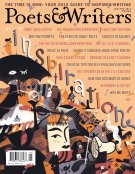As we enter the highway and begin our drive out of town, Williams points to the area where District Six once was. “See 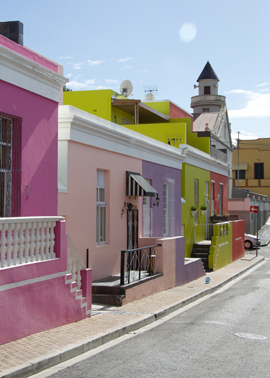 there, just below those red roofed houses,” he says. “All of that area used to be part of the city.” Even from the highway I can see what a beautiful neighborhood it might have been, tucked in the bowl of the city, at the foot of Table Mountain. “That’s where they were living,” Williams says. “Look at all the access to the city and access to the harbor and the gorgeous views.” The only thing that remains, he tells me, are places of worship—a few churches, some mosques. Most of the homes were razed with bulldozers as part of the relocation process. “It was all charming Cape Dutch tenement housing, small houses. There’s a mosque you can see.” He points. “And another mosque.”
there, just below those red roofed houses,” he says. “All of that area used to be part of the city.” Even from the highway I can see what a beautiful neighborhood it might have been, tucked in the bowl of the city, at the foot of Table Mountain. “That’s where they were living,” Williams says. “Look at all the access to the city and access to the harbor and the gorgeous views.” The only thing that remains, he tells me, are places of worship—a few churches, some mosques. Most of the homes were razed with bulldozers as part of the relocation process. “It was all charming Cape Dutch tenement housing, small houses. There’s a mosque you can see.” He points. “And another mosque.”
He explains that the government argued its actions were justified due to gangs and theft and an unhealthy population density. “But the reality of it was: ‘Let’s make our city white,’” Williams says. It is estimated that some sixty thousand people were forcibly removed between 1968 and 1982. Yet because of the controversy surrounding the act and the subsequent international and local pressure, redevelopment by the government was largely halted—and continues to be complicated to this day. In the twenty years since the fall of apartheid in 1994, there have been numerous discussions and negotiations about how to best invest in and redevelop the area, especially considering claims for restitution by those who were relocated. And while there has been limited progress in returning some of the former families to the area, the issue remains a highly contentious and politically complicated one.
Mitchells Plain is one of the predominately “colored” townships, built in the 1970s for the families who were forcible removed from their previous residences, such as those inhabitants of District Six. Today it is home to nearly three hundred thousand people and is one of the largest townships in Cape Town and South Africa. The Joseph Stone Theater is located in Athlone, a suburb of Mitchells Plain, approximately fifteen miles from Cape Town. When we arrive, it reminds me of any number of slightly depressed, midwestern, middle-class cities in the U.S.—wide traffic arteries with medians that could use a mowing, parking lots in front of businesses with rough pavement, sun-faded siding on buildings, modest ranch homes.
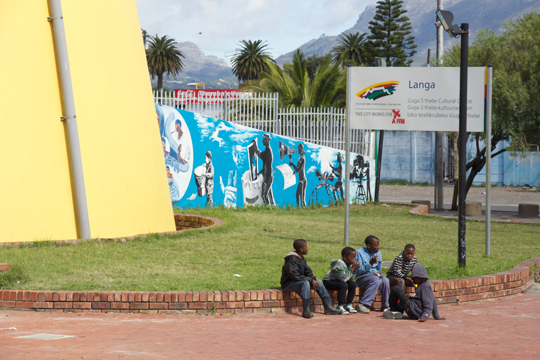
No doubt there are parts of this township that are poverty striken. And in two days, after spending an afternoon walking the suburb of Langa—a township built in the 1920s, before apartheid, as one of the many areas that were designated for black Africans, which today has a populated of approximately fifty thousand residents—I will witness it first-hand. Led by a young man in his twenties, who lives in Langa and works as an interpreter and guide, he will present his home as a study in the diversity of economic class: We walk through quaint parts of the suburb that have modest, single-family brick houses, front yards, and one-car garages; past apartment buildings with laundry strung across balconies and children playing out front in the street; and around one-room claboard houses where women tend open fires to make sheep’s head soup, the heads of the animals lined up on makeshift plywood tables nearby. Near the end of our tour, as a way of illustrating the depth of poverty in which some people live, our guide will take us to Langa’s slum, a place cordoned off from the rest of the township, pinned between the rushing freeway and a wall of cyclone fencing and razor wire, where residents squat in wooden shacks and modified shipping containers, the hodgepodge of buildings creating a labyrinthe of winding, narrow, dirt alleys that one could lose oneself in with only a single wrong turn, a place where the only source of sanitation is a line of port-a-potties several block long, where children wander barefoot between the sun-bleached buildings, where the only adults hide inside in the dark, unlit, single-room buildings (the nicest of which might have a piece of old linoleum laid down over the packed-dirt floor), and where, when we leave, three young girls who have made jangling bracelets out of old beer bottle tops strung on coat hanger wire, which they’ve wrapped around their ankles, will dance, pounding the brown earth with their feet, the bottle caps rattling together in a kind of music, the song they’re singing a language I don’t understand, yet whose message—what can you spare to alleviate this poverty?—is as clear as their eyes and voices.
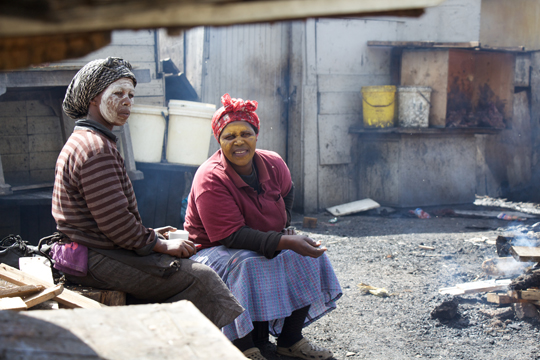
![]()
But I haven’t been to Langa yet, so when we park in front of the modest theater, I won’t fully appreciate what I glimpse as we enter the Joseph Stone. Not yet. On the side of the building, next to the entrance, are dozens and dozens of children’s handprints pressed against the whitewashed cinderblock wall—bright greens and reds and blues and oranges—even more vibrant today in the white glare of the sun. Painted above is a message: “Hands Off Our Children.” And below, the number for a help line.
I also don’t immediately realize how appropriate it is that we’re rehearsing here today—this theater a refuge of sorts for children—because Williams’s breakout book, Crocodile Burning, is a coming-of-age story about a poor boy from the townships, on the verge of becoming a criminal, who stumbles into an audition and discovers he has a talent for singing, landing a part in a musical about young people trying to break free from poverty, a show which eventually becomes successful enough to make it to New York. However, because of its less-than-flattering portrait of life under apartheid, the book wasn’t initially picked up by publishers in South Africa. In fact, it ended up published first in the U.S., in 1992, subsequently winning a Library Assocation Award. Two years later, Oxford University Press took a gamble on the novel and released it in South Africa. The book is now in its thirty-fifth printing, and required reading in many schools.
Part of the reason I don’t make this connection immediately, however, is that I’m rushing to keep up. Williams strides into the theater, out of the bright morning sun, and down a dark hallway to the back of the building, where the company is awaiting his arrival in the dance studio. I am introduced to the set and costume designer, Michael Mitchell; the conductor and chorus master, Albert Horne; and the choreographer, Sbo Naka; as well as the lighting designer, Peter Halbsgut, and the stage manager, Marianne Halbsgut, who happen to be married. These two also happen to have worked for many years in Munich—part of the reason they’ve been brought on for this particular show.
Williams is informed that some of the singers are late because of cabs, and while he and several others try to sort things out, I sneak a look at the director’s table. Spread out across it are the artistic visions of what the show will become, from renderings of the stage, to fashion drawings of the new costumes, to scripts annotated with minute-by-minute timing penciled in the margins. There’s even a miniature model of the stage, no larger than a laptop. It’s a simple design, intended to evoke the inside of a prison: a catwalk across the back; railings for guards to peer down into the yard; and two sets of stairs that ramp down on either side, flanking center stage, descending to the floor to allow the singers access to the structure from either side.
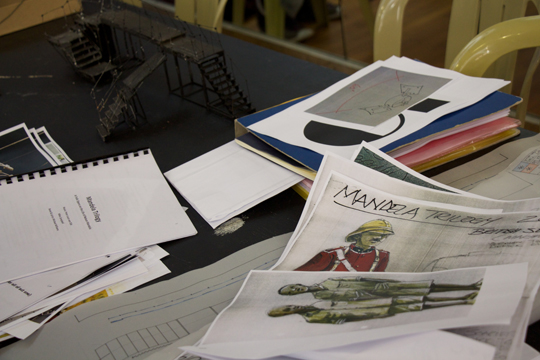
I find a chair in the corner, out of the way. The ballet studio is a big space, with an enormous ceiling that reaches up to the industrial framework overhead. It has honey-colored hardwood, brick walls, and mirrors at opposite ends of the room. The cast sit on plastic yard chairs—white, yellow, blue—in a rough semi-circle, talking and chatting, facing the desk. The majority are black. Some are perhaps of Indian or Malyasian descent. Only one man and one woman in attendance are white. Most of the company appear to be in their late twenties and early thirties.
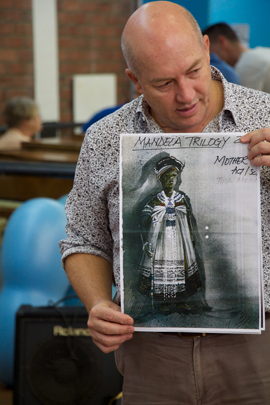 Within a few moments Williams is clapping his hands, calling everyone’s attention. He has talked with excited animation the entire car ride over, and I know he is eager to begin. He welcomes them back, there is a bit of bantering, and then, following some necessary introductions, he launches into the explanation for why there is a new Act One. He wants to share both his thinking and his enthusiasm with the company, and as he talks he paces the floor, gesturing and speaking with his hands.
Within a few moments Williams is clapping his hands, calling everyone’s attention. He has talked with excited animation the entire car ride over, and I know he is eager to begin. He welcomes them back, there is a bit of bantering, and then, following some necessary introductions, he launches into the explanation for why there is a new Act One. He wants to share both his thinking and his enthusiasm with the company, and as he talks he paces the floor, gesturing and speaking with his hands.
There are practical reasons for the changes: In order to make the show more flexible and appealing to European venues, he’s had to reimagine it as an ensemble cast, meaning there will only be thirty performers instead of the original cast of forty-five. This also means that most performers will now play multiple roles. But beyond the pragmatic retooling, the biggest change has come from the inspiration to tell the story of Makhanda, a tribal leader from the early 1800s who’d fought the British and had been imprisoned on Robben Island—just like Mandela, though more than a hundred years earlier.
“And when Makhanda got to Robben Island,” Williams recounts to the company, “he was amazed to find that there were other prisoners from other tribes who were also there. And so he understood that the whole notion of the white imperial forces of Britain coming in to South Africa was not isolated to Grahamstown. So there was a conscious, conscious effort by Makhanda to make them understand that they had to try to break away from the tribal identity and think more of the black peoples of southern Africa.”
Williams goes on to tell how Makhanda and several other men planned an escape together on Christmas Day of 1819. But unfortunately there was a storm and Makhanda was lost overboard and never seen again. However, the people who survived spread word of a prophetic return one day. “There was a saying,” Williams tells the company, “‘When Makhanda returns, we will receive our freedom.’ The spiritual Makhanda. ‘Because with Makhanda’s return, he will liberate us.’
[Photos, from top]
Photo 1: The Bo-Kaap area.
Photo 2: Outside the Guga S’thebe Cultural Center in Langa.
Photo 3: Women tending cook fires for sheep’s head soup in Langa.
Photo 4: The director’s table ready for rehearsal.
Photo 5: Williams shares new costume designs for Act One with the company.








